Historical Markers
Can you help us with photos for this page?Most of these photos are slightly larger than shown - right-click them and Open image in a new tab.
| Anvil Park Ranch, Canadian
Marker Location: from Canadian drive U.S. 60, north about 2 miles to junction with S.H. 2266, turn right on 2266, marker is about 3.5 miles east Year Marker Erected: 1967 Marker Text: Begun 1891 by blacksmith J. C. Studer who came from Kansas in 1886. His occupation inspired Anvil brand and name of ranch. Ran only purebred cattle after 1919. Drew top cattle buyers. Spread grew from two sections to 5,000 acres. Famous for annual professional rodeo 1918 to 1941. Attracted top cowboys from throughout nation. Many stars of rodeo world started here. As many as 8,000 visitors viewed 3-day performances. Ranch was sold 1951 to Texas Parks & Wildlife Commission for game breeding purposes. Recorded Texas Historic Landmark, 1967. | |
| Buffalo Wallow Battle Ground, Canadian
Marker Location: from Canadian, travel south on U.S. 83, approximately 15.5 miles, turn left onto S.H. 277, continue approximately 7 miles to dirt road, take right turn, continue about 1 mile to marker Year Marker Erected: 1925 Marker Text: Here on September 12th, 1874, two scouts and four soldiers defeated 125 Kiowa and Comanche Indians. Scouts: William Dixon, Amos Chapman Soldiers: Sergeant Z. T. Woodall, Co. I; Peter Rath, Co. A; John Harrington, Co.H; George W. Smith, Co. M, 6th Cavalry. Stand Silent: Heroes here have been who cleared the way for other men. Erected by Panhandle-Plains Historical Society, September 12th, 1925. This site marked under direction of J. J. Long, Mobeetie, Texas. Mrs. William Dixon, Miami, Texas. (1966) | |
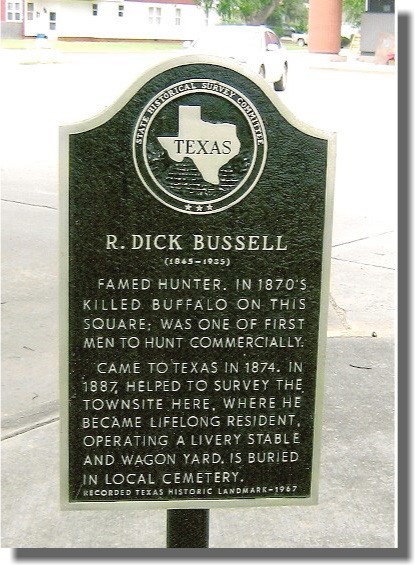 |
Bussell, R. Dick
Marker Location: at Courthouse, Main & 5th Street, Canadian Year Marker Erected: 1967 Marker Text: (1845-1935) Famed hunter, in 1870s killed buffalo on this square; was one of the first men to hunt commercially. Came to Texas in 1874. In 1887, helped to survey the townsite here, where he became lifelong resident, operating a livery stable and wagon yard. Is buried in local cemetery. Recorded Texas Historic Landmark, 1967. |
 |
Canadian Hospital, The Former, Canadian
Marker Location: at intersection of 7th & Elsie Street, Canadian Year Marker Erected: 1970 Marker Text: This building, now a residence, was Canadian's first hospital, opened on June 16, 1917. Funds for construction were obtained by public subscriptions. Dr. H. C. Caylor, first owner, sold to Dr. L. V. Dawson in 1920. From 1924 to 1949, Dr. E. H. Morris was owner. A tornado that killed or hurt some 200 to 260 people in the Glazier- Higgins area (10 to 27 miles northeast) on April 9, 1947, dramatized worth of this hospital - the only one in the immediate vicinity. It was closed in 1949. Recorded Texas Historical Landmark, 1970. |
 |
Canadian River Trail, Canadian
Marker Location: from Canadian, travel on U.S. 60/83 1 mile north, marker is in roadside park Year Marker Erected: 1966 Marker Text: Trade, exploration and hunting trails along the Canadian are older than recorded history -old when used 1541 by Spaniard Coronado hunting golden cities of Cibola. Route in 1840 for Josiah Gregg and 34 Missouri men with goods worth $25,000 headed for trade in Santa Fe. Used by 1849 parties escorted by U.S. Army Captain R. B. Marcy on way to California Gold Rush. Hunters, cattlemen, settlers used Canadian River Trails in1870s and 80s, as Panhandle was opened to civilization. River's name,"Canadian," came from Spanish for "boxed-in." (1966) |
 |
Church Bell, First, Canadian
Marker Location: Purcell & 6th Street, Canadian at Presbyterian Church Year Marker Erected: 1967 Marker Text: Bought in 1890 and placed in old Presbyterian Church, used by several faiths. Was first church bell in Canadian, Hemphill County. Congregation held suppers and other projects to repay bank loan on bell. Later bell was moved to new Presbyterian Church and still is used today. (1967) |
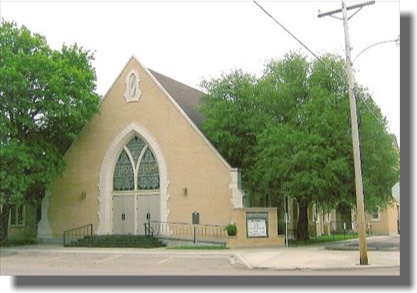 |
First Baptist Church of Canadian, Canadian
Marker Location: Main & 7th Street, Canadian Year Marker Erected: 1995 Marker Text: This church was organized by seven women in 1894 with the help of the Rev. Hatcher, a Baptist minister from Amarillo. Shortly thereafter, about 32 people, converted at a local revival held by the Rev. Abe Mulkey, joined the new congregation. Early services and Sunday School classes were held at several area locations until 1911 when a brick sanctuary was completed. The congregation erected a fellowship hall and education building in 1954 and a new sanctuary in 1960. The church has grown with the community and continues to support various outreach and missionary projects. Sesquicentennial of Texas Statehood 1845-1995. |
 |
First National Bank of Canadian, Canadian
Marker Location: 2000 Main Street, Canadian Year Marker Erected: 1970 Marker Text: Successor to first bank in Texas Panhandle: the Traders' Bank at Canadian, organized by Henry Hamburg and Robert Moody on August 1, 1887. In 1892 Moody and D. J. Young, his son-in-law, established the Canadian Valley Bank. The two men converted it into the First National Bank of Canadian in 1903. Moody was an official at all three banks. The present structure was built in 1920. Architect was J. C. Berry. Recorded Texas Historic Landmark, 1970. |
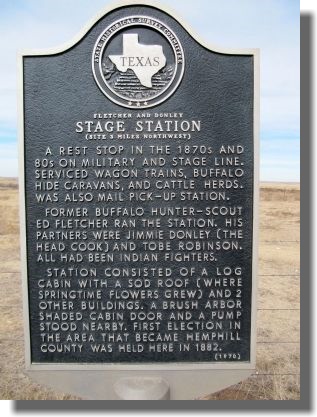 |
Fletcher & Donley Stage Station, Canadian
Marker Location: Site 3 miles northwest Year Marker Erected: 1970 Marker Text: A rest stop in the 1870s and '80s on military and stage line. Serviced wagon trains, buffalo hide caravans, and cattle herds. Was also mail pick-up station. Former buffalo hunter-scout, Ed Fletcher ran the station. His partners were Jimmie Donley (the head cook) and Tobe Robinson. All had been Indian fighters. Station consisted of a log cabin with a sod roof (where springtime flowers grew) and (2) other buildings. A brush arbor shaded cabin door and a pump stood nearby. First election in the area that became Hemphill County was held here in 1882. (1970) |
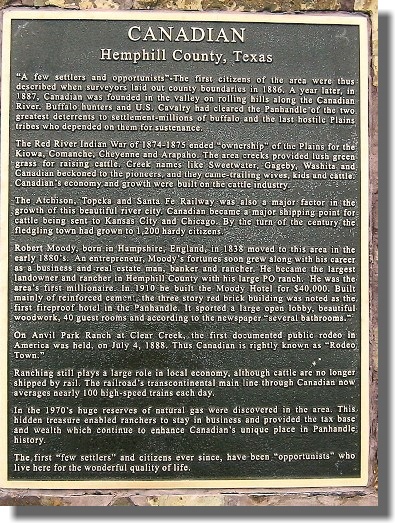 |
Hemphill County, Canadian
Marker Location: from Canadian, travel on US 60, north about 1 mile, marker located at roadside park Year Marker Erected: 1936 Marker Text: Formed form Young and Bexar territories. Created, August 21, 1876. Organized, July 5, 1886. Named in honor of John Hemphill, 1809-1862. First Chief Justice of the Supreme Court of the State of Texas. Adjutant General of the Somervell Expedition. Member of the first State Constitutional Convention. Member of the United States Congress. Canadian, the county seat. (1936) |
| Hemphill County Courthouse, Canadian
Service Dates: 1909-present Substantial Modifications: Renovated in 1964: metal windows, metal door entry. Elevator installed and jail added in 1982 | |
 |
Hemphill County Jail, Canadian
Marker Location: Courthouse Square, Main & 5th Street, Canadian Year Marker Erected: 1970 Marker Text: Built in 1890, first permanent public building in both town of Canadian and Hemphill County. Erected under administration of E. E. Polly, first county judge. Ironically, deception plagued construction of this jail, as building contracts were found to be fraudulent and citizens took legal action all the way to the Texas Supreme Court (1889). In mid-1920s, jail held outlaws from notorious oil boom town of Borger (65 miles southwest). Recorded Texas Historic Landmark, 1970. |
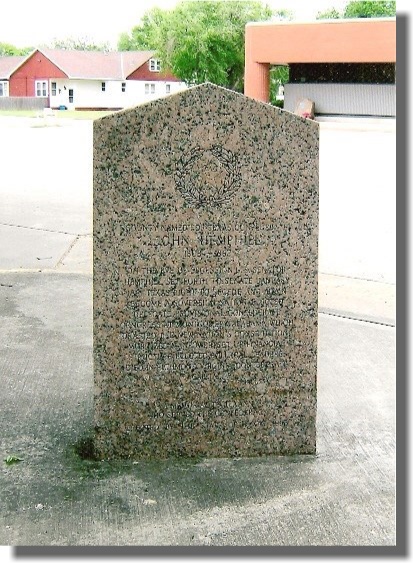 |
Hemphill, John, Canadian
Marker Location: at Courthouse, Main & 5th Street, Canadian Year Marker Erected: 1963 Marker Text: (1803 - 1862) Star and Wreath On the eve of secession U.S. Senator Hemphill set forth to Senate January 1861 Texas right to secede and again became a sovereign nation. Elected delegate provisional Confederate Congress at Montgomery, Alabama which drafted the new nation's constitution, mobilized manpower, set up financial structure, elected political leaders. Died in Richmond, Virginia, Confederate capital. A memorial to Texans who served the Confederacy erected by the State of Texas 1963. |
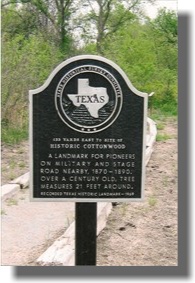 |
Historic Cottonwood,
133 Yards East to Site of, Canadian Marker Location: from Canadian, drive north on U.S. 60, turn right onto FM 2266, about 12 miles to Lake Marvin, turn left at fork at Lake Marvin entrance, at .7 mile turn to right down dirt road, continue .3 mile to marker site Year Marker Erected: 1969 Marker Text: A landmark for pioneers on military and stage road nearby, 1870-1890. Over a century old, tree measures 21 feet around. Recorded Texas Historical Landmark, 1969. |
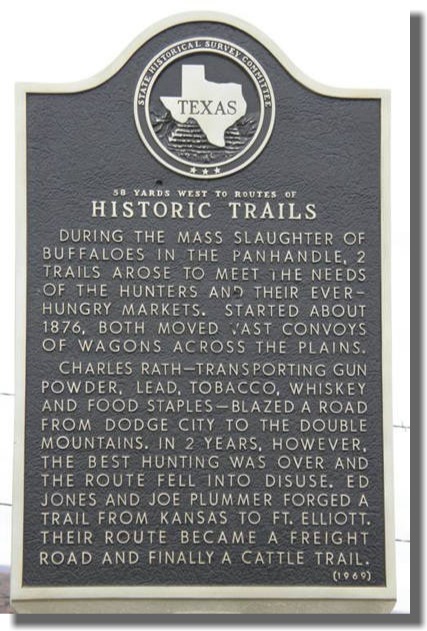 |
Historic Trails, Canadian
Marker Location: from Canadian, drive about 6.5 miles south on US 60/83, marker is on west side of divided highway Year Marker Erected: 1969 Marker Text: During the mass slaughter of buffaloes in the Panhandle, two trails arose to meet the needs of the hunters and their ever-hungry markets. Started about 1876, both moved vast convoys of wagons across the plains. Charles Rath-- transporting gun powder, lead, tobacco, whiskey, and food staples-- blazed a road from Dodge City to the Double Mountains. In two years, however, the best hunting was over and the route fell into disuse. Ed Jones and Joe Plummer forged a trail from Kansas to Fort Elliott. Their route became a freight road and finally a cattle road. |
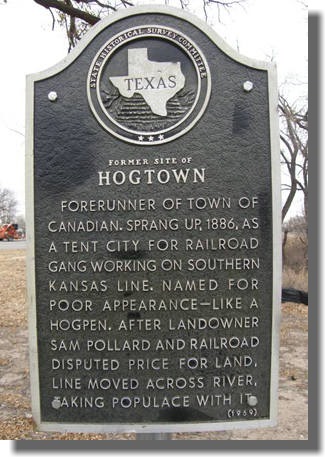 |
Hogtown, Former Site of
Marker Location: Not located. Year Marker Erected: 1969 Marker Text: Forerunner of town of Canadian. Sprang up, 1886, as a tent city for railroad gang working on Southern Kansas line. Named for poor appearance-- like a hogpen. After landowner Sam Polland and railroad disputed price for land, line moved across river, taking populace with it. (1969) |
| Howe, Gene, Wildlife Management Area, Canadian
Year Marker Erected: 1963 Marker Text: The Gene Howe Wildlife Management Area contains approximately 6,000 acres of upland sandhills, pastures, natural meadows and woodlands fronting the north bank of the Canadian River. Named for Eugene A. Howe, Amarillo newspaper publisher, dedicated conservationist and member of the Texas Game and Fish Commission for more than 19 years, the area was acquired by the State in 1951. The objectives to develop, through research and demonstration, better methods of game management which can be applied to major vegetative types found in the High Plains and Panhandle regions of Texas. Chief projects on the area involve the white-tailed deer, wild turkey, bobwhite quail and migratory waterfowl. Lesser prairie chickens and ring-necked pheasants may be found throughout the year and winter brings a wide variety of visiting shorebirds. To improve wildlife habitat and increase the yield of natural foods for wildlife, dikes have been constructed to create marshes which are planted with waterfowl food plants; brush clearing have been made in the cottonwood thickets and bottomlands to provide suitable feeding areas and game openings; small grain is sowed for winter feeding of deer and turkey. Scientific information acquired through work done on this Federal-State cooperative project is available to surrounding landowners and others who are interested. Game surpluses produced on the area are harvested periodically by hunters under a controlled public hunt program. (1963) | |
| Isaacs, Mary B., Canadian
Marker Location: located at Canadian Middle School, intersection of Bungalow & 6th Street, Canadian Year Marker Erected: 1967 Marker Text: Born in Massachusetts. Came to Texas, 1888, as Hemphill County's first public school teacher. Often saw Indians darken the schoolroom windows trying to watch her classes recite Married Will C. Isaacs in 1892. Founder and guiding spirit of The Canadian Women's Christian Temperance Union, an organization she served for 44 years. Under her leadership, W. C. T. U. building doubled as community center and now houses the city library. Achievements of this pioneer teacher and civic leader were commemorated in naming of the Mary B. Isaacs Elementary School. (1967) | |
| Jones Mansion, Canadian
Marker Location: 6th & Main Streets, Canadian Year Marker Erected: 1983 Marker Text: Prominent area rancher Thomas Stanley Jones, a native of Wales, had this home built in 1910 for his wife, Rosalie (Whaley), and their children. Designed by Amarillo architect E. Wellington, it was the first brick residence constructed in Canadian. Reflecting its builder's prominence in the town, the classical revival mansion features monumental Ionic columns, red brick corner quoins, and renaissance detailing. Recorded Texas Landmark Landmark, 1983. | |
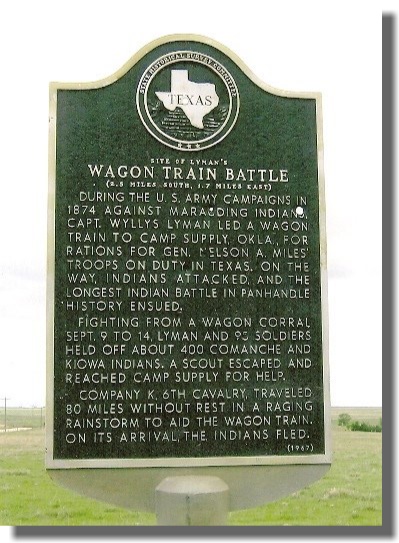 |
Lyman's Wagon Train Battle, Site of, Canadian
Marker Location: from Canadian, travel south on US 60/83 approximately 7 miles, turn east on SH 33 and go about 10 miles - marker is on south side of road. Year Marker Erected: 1967 Marker Text: During the US Army Campaigns in 1874 against marauding Indians, Capt Wyllys Lyman led a wagon train to Camp Supply, Okla, for rations for Gen. Nelson A Miles' troops on duty in Texas. On the way, Indians attacked, and the longest Indian battle in Panhandle history ensued. Fighting from a wagon corral, Sept 9 to 14, Lyman and 95 soldiers held off about 400 Comanche and Kiowa Indians. A scout escaped and reached Camp Supply for help. Company K, 6th Calvary, traveled 80 miles without rest in a raging rainstorm to aid the wagon train. On its arrival, the Indeans fled. (1967) |
| Marcy Trail, Route of, Canadian
Marker Location: from Canadian, drive on US 60, south about 8 miles, marker is on west side of the highway Year Marker Erected: 1969 Marker Text: This overland route, blazed in 1849 by energetic and efficient Army Captain R. B. Marcy, was best known as part of the California Gold Trail. Starting in Oklahoma, Marcy led an expedition across the Texas Panhandle and back through central West Texas. Both of the wagon roads he laid out served the emigrant traffic. In 1853, this section was planned as part of the route for the first transcontinental railroad in America, but the Civil War shifted sentiment to northern routes. Its importance declined after the railroad came through this county, 1887. (1969) | |
| McGee, Tom T., Canadian
Marker Location: Canadian Cemetery, located in the east section -Canadian Year Marker Erected: 1967 Marker Text: (Sept. 13, 1849 - Nov. 24, 1894) Came to Canadian about 1884. Was foreman on Po Ranch prior to election as first sheriff of Hemphill County, 1887 - year city of Canadian was founded. Nov. 23, 1894, in gun fight with (6) men attacking large shipment of money at Wells, Fargo & Company, he was mortally wounded, and he died the next day. His widow went to England as a volunteer civilian worker in World War I; died there. Ashes were returned here for burial. Recorded, 1967 | |
| Miles Expedition, General Nelson Miles' Headquarters Dugout, Canadian
Marker Location: US 83, just north of Washita River Year Marker Erected: 1967 Marker Text: Indian raids brought Miles' men to Texas from North in 1874 as part of U.S. Army pincer's tactic operating from a dugout post. The 12 Infantry and cavalry units had supply camps on the Canadian, Red and Washita rivers. On November 8, 1874, Miles' troops recovered three captive German sisters; fought 8 Indian battles during winter. At this post General Miles nominated for Medal of Honor several of his men -- among them renowned Panhandle settler, Billy Dixon. In 1875, Fort Elliott was opened at Old Mobeetie to continue frontier protection. (1967) | |
| Military Road, Old, Canadian
Marker Location: from Canadian, drive US 60, north about 3 miles, turn east on FM 2266, marker is located about 12 miles east at entrance to Black Kettle National Grassland Campground Year Marker Erected: 1969 Marker Text: (1874 - 1890) One of earliest known Texas Panhandle trails. Flint-pierced mastodon bones show prehistoric men trailed this valley before Indians were here. In 1875, U.S. Army came this way to Fort Elliott, at Mobeetie (30 miles, southwest). Mail routes and stagecoaches used this trail, 1878-1890. (1969) | |
| Moody Hotel, Canadian
Marker Location: insection of Main & 2nd Streets -Canadian Year Marker Erected: 1970 Marker Text: In 1910 Canadian was a thriving railroad and marketing center with a Baptist Academy. English-born Robert Moody (1838-1915), a rancher, banker and trustee of the academy, decided to build a hotel that would reflect the town's prosperity. On the site of the former McIntosh Hotel, he began construction of this brick veneered building. The 3-story facility opened in late 1910 with 40 guest rooms and a beautiful oak stairway. The Moody Hotel became a local landmark and a popular stop for visitors until changing travel customs caused it to close. (1978) | |
| A rest stop in the 1870s and 80s
Marker Location: Located 21 & 8/10 mile SE of Canadian on US 277. Year Marker Erected: 1970 Marker Text: A rest stop in the 1870s and 80s on military and stage line. Serviced wagon trains, buffalo hide caravans, and cattle herds. Was also mail pick-up station. Former buffalo hunter-scout Ed Fletcher ran the station. His partners were Jimmie Donley (the head cook) and Tobe Robinson. All had been Indian fighters. Station consisted of a log cabin with a sod roof (where springtime flowers grew) and 2 other buildings. A brush arbor shaded cabin door and a pump stood nearby. First election in the area that became Hemphill County was held here in 1882. | |
| River Valley Pioneer Museum, Canadian
Mailing Address: P O Box 1201 City: Canadian Zip code: 79014 Street Address: 118 N 2nd Area Code: 806 Phone: 323-6548 Email Address: rvmuseum@arn.net Types of Exhibits/Collections: Art, Natural History, Archeology, Photos, Historical, Local/Pioneer History Educational Programs: Guided Tours, Self-guided tours, Traveling Trunks, Hands-on Activities for Children, Demonstrations, Intrepretive Drama, School/Museum Cooperative Curriculum, Special Programs/Accomodations for Disabled Visitors | |
 |
Springer's Road Ranch, Site of Old, Canadian
Year Marker Erected: 1967 Marker Text: First post office in Hemphill County. Unique for tunnel from dugout home-store to corral. On 1870's trail from Fort Elliott (35 miles, southwest) to Fort Supply, Indian Territory, to Fort Dodge, Kansas. Established by A. G. Springer; besides running 300 head of cattle, Springer's was a stagecoach stand, tavern; store (mainly for teamster, hunters) had liquor, canned goods, hunting equipment. Poker-expert Springer was frequent host to soldiers seeking entertainment in tavern. In 1877, he and Tom Ledbetter, his partner, were killed in gun battle with angered soldiers and were buried at the ranch. (1967) |
| W. C. T. U. Building, Canadian
Marker Location: 500 Main Street, Canadian Year Marker Erected: 1965 Marker Text: Only structure in the nation built, owned and still operated by a local chapter of Women's Christian Temperance Union. Built 1911, with financing and upkeep from annual bazaars held since 1906. Also, used by public library and civic groups. Determined to abolish liquor by local option election, the chapter organized in 1902. Won first election a year later. Meetings have been held every Wednesday since founding. Recorded Texas Historic Landmark, 1965 | |
| Wood, Sam, Cabin, Canyon
Marker Location: located at Panhandle-Plains Museum, in Canyon, Randall County Year Marker Erected: 1966 Marker Text: Sam Wood cabin built in 1887 at Hog Town (now a ghost town). Wood, an Indian Scout, Union veteran of Civil War, buffalo hunter, was father of bride in first marriage recorded in the Panhandle, at Fort Elliott in 1877. Cabin housed (6) families during an Indian scare, in 1954 it was moved, restored. Recorded Texas Historic Landmark, 1966. | |
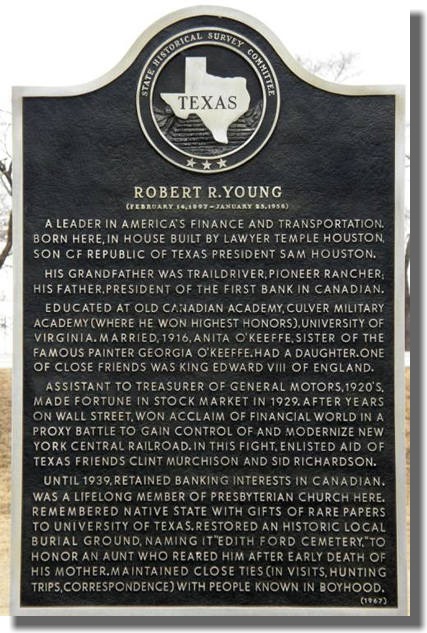 |
Young, Robert R., Canadian
Marker Location: from Canadian, drive on US 60 about 1 mile north, marker is in roadside park Year Marker Erected: 1967 Marker Text: (February 14, 1897 - January 25, 1958) A leader in America's finance and transportation. Born here, in house built by lawyer Temple Houston, son of Republic of Texas President Sam Houston. His grandfather was traildriver, pioneer rancher; his father, president of the first bank in Canadian. Educated at Old Canadian Academy, Culver Military Academy (where he won highest honors), University of Virginia. Married, 1916, Anita O'Keeffe, sister of the famous painter Georgia O'Keeffe. Had a daughter. One of close friends was King Edward VIII of England. Assistant to treasurer of General Motors, 1920s. Made fortune in stock market in 1929. After years on Wall Street, won acclaim of financial world in a proxy battle to gain control of and modernize New York Central Railroad. In this fight, enlisted aid of Texas friends Clint Murchison and Sid Richardson. Until 1939, retained banking interests in Canadian. Was a lifelong member of Presbyterian church here. Remembered native state with gifts of rare papers to University of Texas. Restored an historic local burial ground, naming it "Edith Ford Cemetery," to honor an aunt who reared him after early death of his mother. Maintained close ties (in visits, hunting trips, correspondence) with people known in boyhood. (1967) |